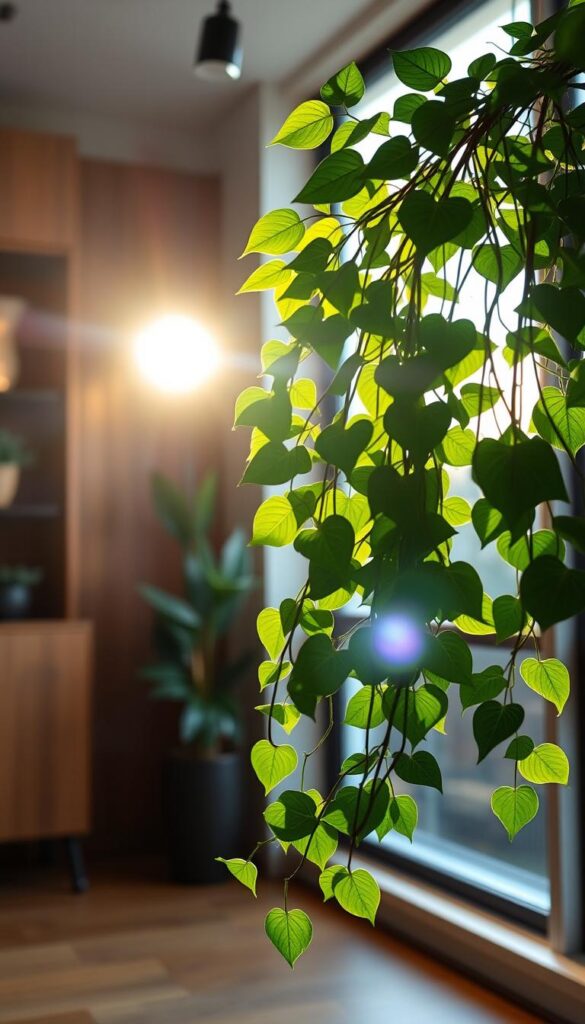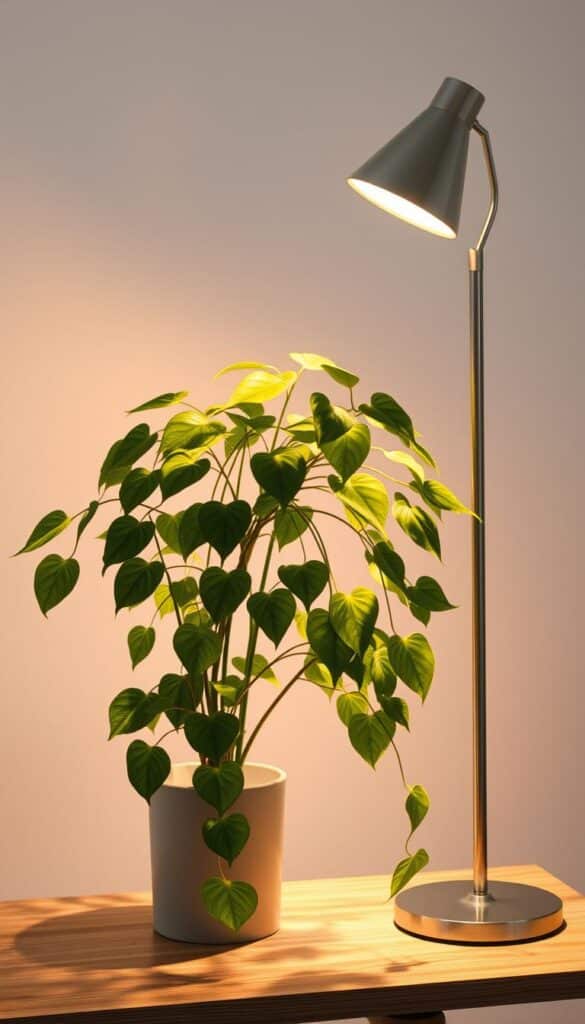When I first brought my golden pothos home, I thought giving it a spot by the sunny window would be ideal. But within weeks, its leaves began to turn brown, and the plant looked stressed. I soon realized that finding the right balance of light was crucial for its survival.
Golden pothos plants thrive in bright, indirect light, but direct sunlight can scorch their leaves. East- or west-facing windows offer the best balance, providing gentle morning or afternoon light without the harsh midday sun. If natural light is scarce, LED grow lights can be a game-changer, offering the right spectrum for healthy growth.
Understanding your plant’s lighting needs is the key to transforming it from a struggling specimen into a lush, vibrant focal point. By adjusting its position and supplementing with artificial light when necessary, you can ensure your golden pothos flourishes indoors.
Introduction to Pothos Lighting
Lighting plays a crucial role in the health and appearance of my golden pothos. Proper illumination not only enhances leaf color but also ensures robust growth. I’ve learned that both too little and too much light can harm this plant.
Why Lighting is Essential for Pothos Growth
Golden pothos requires balanced light to maintain its vibrant variegation. Insufficient light can cause the leaves to lose their golden hues, turning them a dull green. On the flip side, excessive light, especially direct sunlight, can scorch the leaves, leading to brown spots.
An Overview of Light Preferences and Challenges
My golden pothos thrives in bright, indirect light. East- or west-facing windows are ideal, providing gentle morning or afternoon light. However, direct sunlight, especially during peak hours, can be detrimental. If natural light is scarce, LED grow lights can supplement the plant’s needs effectively.
| Light Preference | Impact on Plant |
|---|---|
| Bright, Indirect Light | Promotes healthy growth and vibrant variegation |
| Low Light | Leaves may lose variegation and turn green |
| Direct Sunlight | Can cause leaf burn and brown spots |
Maintaining the right balance of light is key to keeping my golden pothos happy and healthy. By understanding its lighting needs and adjusting its environment, I can ensure my plant remains a stunning addition to my indoor space.
Addressing Your pothos lighting needs
Ensuring your plant gets the right amount of light is just one part of the equation. To create a thriving environment, it’s essential to balance light with other care elements like water, soil, and humidity.
Understanding Light Intensity and Exposure
To measure light intensity, I use a simple method: observing the plant’s natural behavior. If the leaves are a vibrant golden color, it’s a sign of adequate bright, indirect light. I also consider the time of day, ensuring my plant isn’t exposed to harsh midday sun, which can cause scorching.
Common Lighting Pitfalls and How to Avoid Them
Overexposure is a common mistake. It can lead to rapid water loss and root damage. To prevent this, I place sheer curtains over sunny windows. I also check soil moisture regularly to avoid overwatering, which can worsen root issues. Maintaining balanced humidity levels supports the plant’s health, and I find that a humidifier helps during dry months.

By adjusting light exposure and monitoring water and soil conditions, I’ve created a harmonious environment for my plant. This careful balance fosters robust growth and vibrant foliage.
Optimal Lighting Conditions for Golden Pothos
Creating the perfect environment for my golden pothos involves more than just placing it anywhere. The right lighting is crucial for its health and beauty.
Bright, Indirect Light – The Sweet Spot
Golden pothos thrives in bright, indirect light. This type of light keeps the leaves vibrant and promotes healthy growth. I place my plant near east- or west-facing windows for gentle morning or afternoon light. Sheer curtains help filter harsh midday sun, ensuring the leaves stay intact.
Avoiding Direct Sunlight and Leaf Burn
Direct sunlight can be harmful, causing brown spots on the leaves. To avoid this, I use sheer curtains or LED grow lights. These alternatives provide the right light spectrum without the risk of scorching.
Good drainage is also essential. It complements the lighting by preventing overwatering, which can damage roots. Proper care in lighting and drainage keeps my plant vibrant and healthy.
Adapting Indoor Light and Seasonal Variations
As the seasons change, so does the light in my home. I’ve learned to adjust my golden pothos’s placement to keep it thriving year-round.
Seasonal Impacts on Pothos Growth
Summer brings intense sunlight, which can be too harsh for my plant. I notice the leaves can get scorched if it’s too close to the window. In winter, the light is dimmer, and my plant grows slower. This seasonal shift means I need to be mindful of its environment.
Adjusting Indoor Placement for Consistent Light
To keep my golden pothos happy, I move its pot closer to the window in winter and farther away in summer. Sheer curtains help filter the intense summer sun, while in winter, I rotate the plant to ensure even growth. This careful adjustment keeps the leaves vibrant and healthy.
| Season | Lighting Adjustment | Plant Response |
|---|---|---|
| Summer | Move pot away from direct sun, use sheer curtains | Prevents leaf scorch, maintains vibrant color |
| Winter | Move pot closer to window, ensure indirect light | Supports slower but steady growth |
By adapting to these seasonal changes, I create a stable environment for my golden pothos. This attention to detail ensures it remains a lush, thriving part of my home.
Supplemental and Artificial Lighting Strategies
When natural sunlight is scarce, artificial lighting becomes a lifesaver for my pothos plant. I’ve found that supplemental lighting not only bridges the gap on cloudy days but also ensures consistent growth throughout the year.
Choosing the Right Grow Light for Your Space
Selecting the perfect grow light involves balancing energy efficiency and intensity. LED grow lights are my top choice due to their low heat output and adjustable spectrum. They provide the necessary bright light without risking leaf burn. Fluorescent lights are another viable option, especially for those on a budget, though they may require more frequent replacement.
Positioning and Maintaining Optimal Light Levels
Proper positioning is key to avoiding leaf scorch. I place grow lights 6-12 inches above my pothos, ensuring even coverage. Using a light meter helps maintain optimal foot-candles—aiming for 250-500 for medium-light plants. This setup mimics natural light cycles, typically 12-14 hours daily, promoting healthy growth.
DIY Tips for Enhancing Your Plant’s Environment
For a cozy environment, I use sheer curtains to diffuse harsh sunlight and rotate my plant for even growth. DIY shelves with built-in LED strips offer space-saving solutions. These small adjustments create a stable setting that supports my pothos plant’s aesthetic and health.
| Light Type | Efficiency | Lifespan | Heat Emission |
|---|---|---|---|
| LED | High | 50,000+ hours | Low |
| Fluorescent | Medium | 10,000+ hours | Moderate |

By integrating artificial lighting, I maintain a thriving environment for my pothos plant, ensuring it stays vibrant and healthy year-round.
Monitoring, Troubleshooting, and Adjusting Light Exposure
Keeping your plant healthy requires more than just placing it in a sunny spot. It’s about observing, adjusting, and ensuring the right balance of light.
Identifying Early Signs of Light Stress
I always keep an eye out for yellowing leaves or uneven growth, which can signal light stress. Using a light meter helps me confirm if my plant is getting enough light. If the leaves turn yellow, it might be getting too much direct light. On the other hand, if the stems grow long and leggy, it’s likely not getting enough light.
Practical Troubleshooting for Common Issues
If I notice too much or too little light, I reposition my plant near a different window or adjust the sheer curtains. For example, moving it away from direct sunlight in summer and closer in winter maintains the right balance. A helpful tip is to make gradual changes, giving the plant time to adapt without stress.
| Issue | Solution |
|---|---|
| Yellow leaves | Reduce direct sunlight exposure |
| Leggy growth | Increase light exposure |
| Slow growth | Ensure 12-14 hours of indirect light daily |
Regular monitoring and small adjustments help keep my plant thriving. It’s all about finding that sweet spot where everything works in harmony.
Encouraging a Bright Future for Your Pothos
As I look back on my journey with my houseplant, I’m amazed at how much it has thrived with the right light adjustments. Over the weeks, I’ve noticed steady growth, and by the end of each year, it’s transformed into a lush, vibrant companion. This progress wouldn’t have been possible without consistent monitoring and small tweaks to its environment.
I encourage fellow plant enthusiasts to experiment patiently with their houseplant’s lighting. The satisfaction of seeing your plant flourish over time is incredibly rewarding. Remember, it’s all about balance—too much or too little light can lead to issues like yellowing leaves or leggy growth.
By staying proactive and attentive to your plant’s needs, you can prevent recurring problems and ensure it continues to thrive. Each year brings new opportunities to refine its care, creating a nurturing home where your houseplant can shine. Embrace the journey, and your pothos will reward you with beauty and vitality for years to come.
